LeetCode树与图
Ban
ChangAn University二叉树
二叉树基础
二叉树前序遍历
#include <iostream>
#include <vector>
#include <algorithm>
#include <stack>
#include <queue>
using namespace std;
struct TreeNode
{
int val;
TreeNode *left;
TreeNode *right;
TreeNode(int x) : val(x), left(NULL), right(NULL) {}
};
/*
前序遍历
*/
void preorder_print(TreeNode *node, int layer)
{
if (!node)
{
return;
}
for (int i = 0; i < layer; i++)
{
printf("-----");
}
printf("[%d]\n", node->val);
preorder_print(node->left, layer + 1);
preorder_print(node->right, layer + 1);
}
int main()
{
TreeNode a(1);
TreeNode b(2);
TreeNode c(5);
TreeNode d(3);
TreeNode e(4);
TreeNode f(6);
a.left = &b;
a.right = &c;
b.left = &d;
b.right = &e;
c.right = &f;
preorder_print(&a, 0);
return 0;
}
//java code
class TreeNode {
int val;
TreeNode left;
TreeNode right;
TreeNode(int val) {
this.val = val;
}
}
class Test {
public static void preorderPrint(TreeNode node, int layer) {
if (node == null) {
return;
}
for (int i = 0; i < layer; i++) {
System.out.print("-----");
}
System.out.format("[%d]\n", node.val);
preorderPrint(node.left, ++layer);
preorderPrint(node.right, ++layer);
}
public static void main(String[] args) {
TreeNode a = new TreeNode(1);
TreeNode b = new TreeNode(2);
TreeNode c = new TreeNode(5);
TreeNode d = new TreeNode(3);
TreeNode e = new TreeNode(4);
TreeNode f = new TreeNode(6);
a.left = b;
a.right = c;
b.left = d;
b.right = e;
c.right = f;
preorderPrint(a, 0);
}
}
//伪代码
//中序
preOrderPrint(node.left, ++layer);
System.out.format("[%d]\n", node.val);
preOrderPrint(node.right, ++layer);
//后序
preOrderPrint(node.left, ++layer);
preOrderPrint(node.right, ++layer);
System.out.format("[%d]\n", node.val);
113 Path Sum II(Medium)
Given a binary tree and sum, find all root-to-leaf paths where each path's sum equals the given sum
Note: A leaf is a node with no child

struct TreeNode
{
int val;
TreeNode *left;
TreeNode *right;
TreeNode(int x) : val(x), left(NULL), right(NULL) {}
};
class Solution
{
private:
void preorder(TreeNode *node, int &path_value, int sum, vector<int> &path,
vector<vector<int>> &result)
{
if (!node)
{
return;
}
path_value += node->val;
//1
path.push_back(node->val);
//到达叶节点
if ((!node->left) && (!node->right) && (path_value == sum))
{
result.push_back(path);
}
preorder(node->left, path_value, sum, path, result);
preorder(node->right, path_value, sum, path, result);
path_value -= node->val;
//3.遍历例完毕,将该节点从路径中弹出
path.pop_back();
}
public:
vector<vector<int>> pathSum(TreeNode *root, int sum)
{
vector<vector<int>> result;
vector<int> path;
int path_value = 0;
preorder(root, path_value, sum, path, result);
return result;
}
};
int main()
{
TreeNode a(5);
TreeNode b(4);
TreeNode c(8);
TreeNode d(11);
TreeNode e(13);
TreeNode f(4);
TreeNode g(7);
TreeNode h(2);
TreeNode i(5);
TreeNode j(1);
a.left = &b;
a.right = &c;
b.left = &d;
d.left = &g;
d.right = &h;
c.left = &e;
c.right = &f;
f.left = &i;
f.right = &j;
Solution solve;
vector<vector<int>> result = solve.pathSum(&a, 22);
for (int i = 0; i < result.size(); i++)
{
for (int j = 0; j < result[i].size(); j++)
{
printf("[%d]", result[i][j]);
}
printf("\n");
}
system("pause");
return 0;
}
class TreeNode {
int val;
TreeNode left;
TreeNode right;
TreeNode(int val) {
this.val = val;
}
}
class Solution {
private List<Integer> path = new ArrayList<>();
private List<List<Integer>> result = new ArrayList<>();
private int pathValue = 0;
public List<List<Integer>> pathSum(TreeNode root, int sum) {
if (root == null) {
return result;
}
pathValue += root.val;
path.add(root.val);
if (root.left == null && root.right == null && pathValue == sum) {
result.add(new ArrayList<>(path));
}
pathSum(root.left, sum);
pathSum(root.right, sum);
pathValue -= root.val;
path.remove(path.size() - 1);
return result;
}
}
class Test {
public static void main(String[] args) {
TreeNode a = new TreeNode(5);
TreeNode b = new TreeNode(4);
TreeNode c = new TreeNode(8);
TreeNode d = new TreeNode(11);
TreeNode e = new TreeNode(13);
TreeNode f = new TreeNode(4);
TreeNode g = new TreeNode(7);
TreeNode h = new TreeNode(2);
TreeNode i = new TreeNode(5);
TreeNode j = new TreeNode(1);
a.left = b;
a.right = c;
b.left = d;
d.left = g;
d.right = h;
c.left = e;
c.right = f;
f.left = i;
f.right = j;
Solution solve = new Solution();
List<List<Integer>> result = solve.pathSum(a, 22);
for (int k = 0; k < result.size(); k++) {
for (int l = 0; l < result.get(k).size(); l++) {
System.out.format("[%d]", result.get(k).get(l));
}
System.out.println("\n");
}
}
}
236 Lowest Common Ancestor of a Binary Tree(Medium)
Given a binary tree, find the lowest common ancestor(LCA) of two given nodes in the tree.
According to the definition of LCA on Wikipedia :“The lowest common ancestor is defined between two nodes p and q as the lowest node in T that has both p and q as descendants (where we allow a node to be a descendant of itself).”
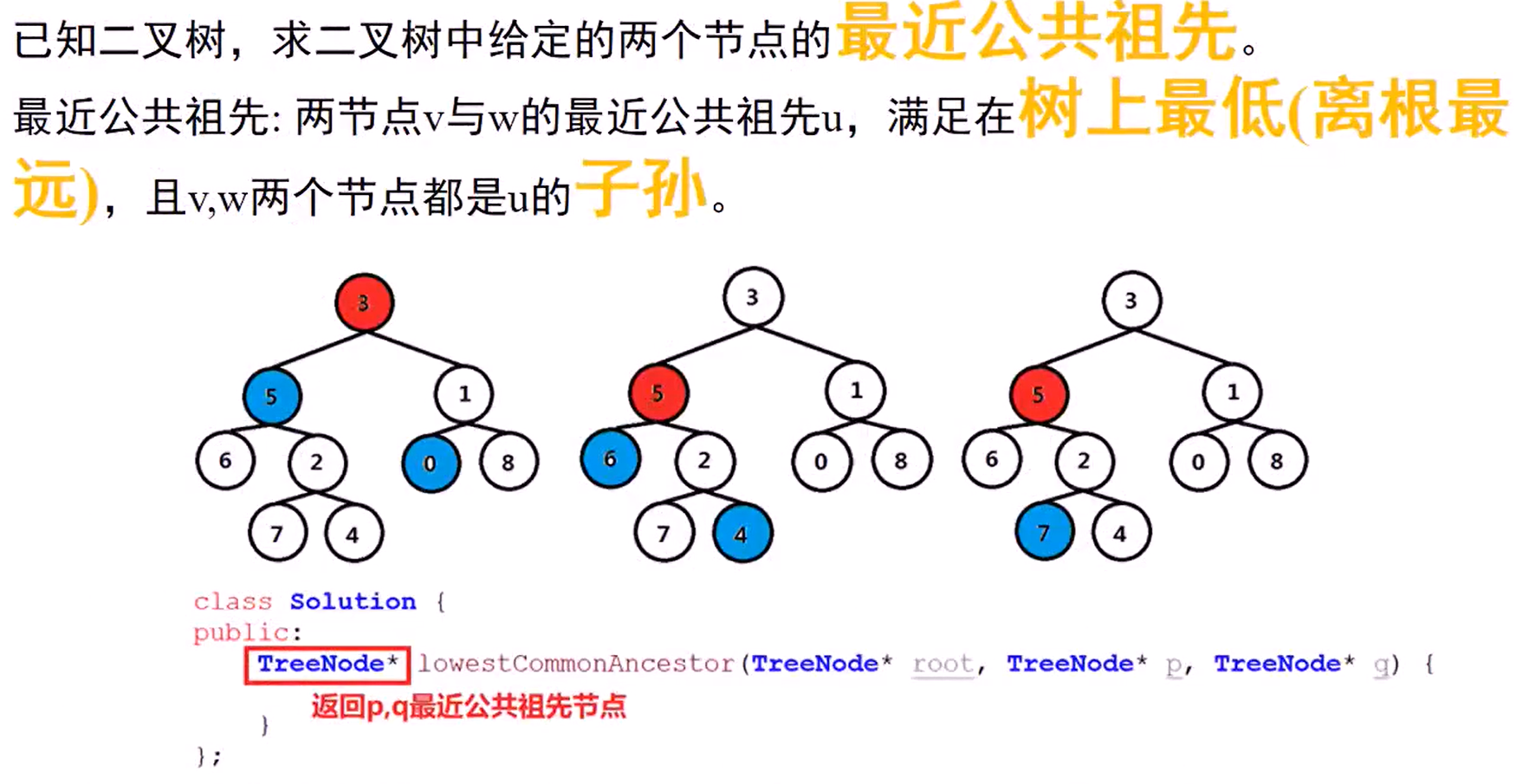
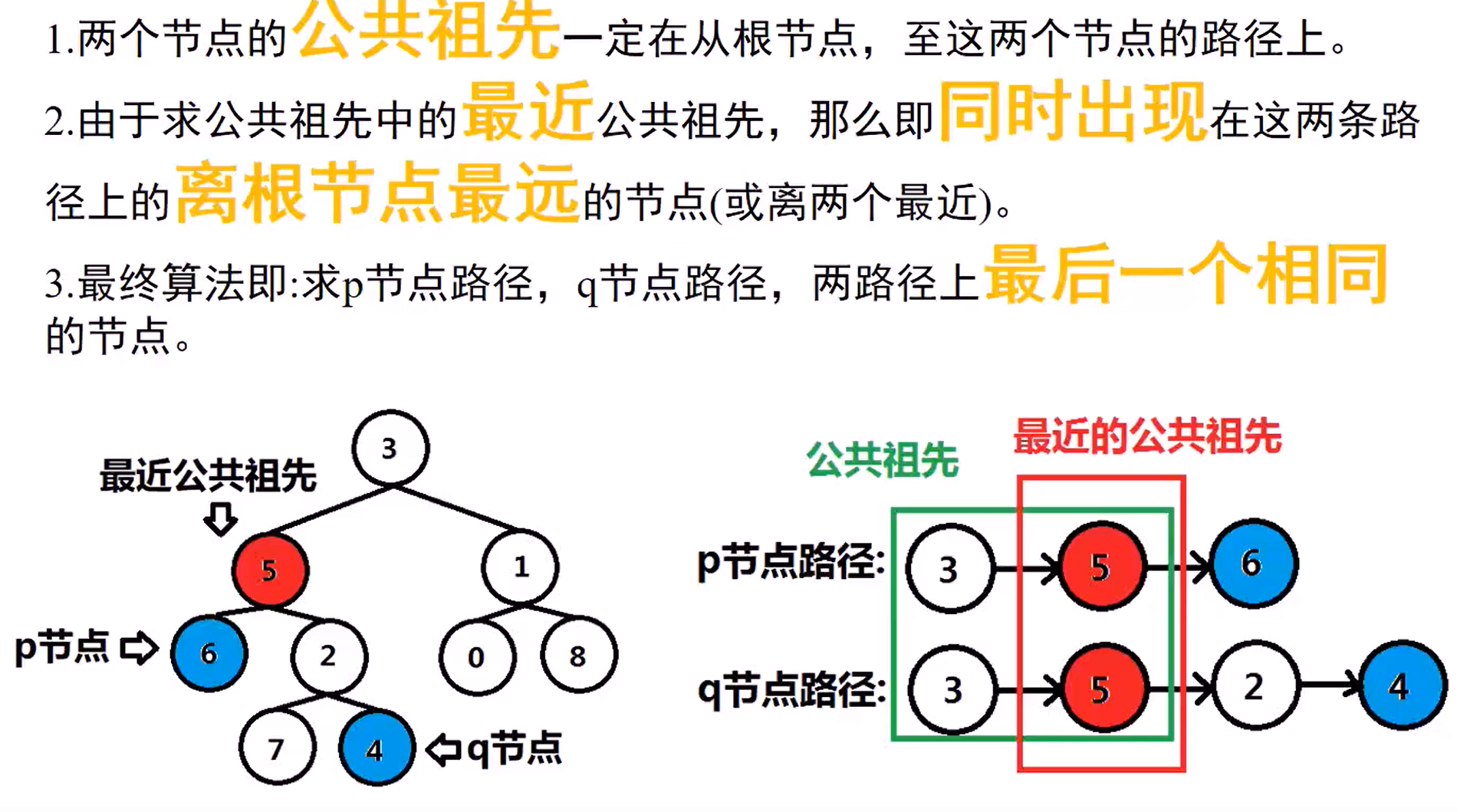
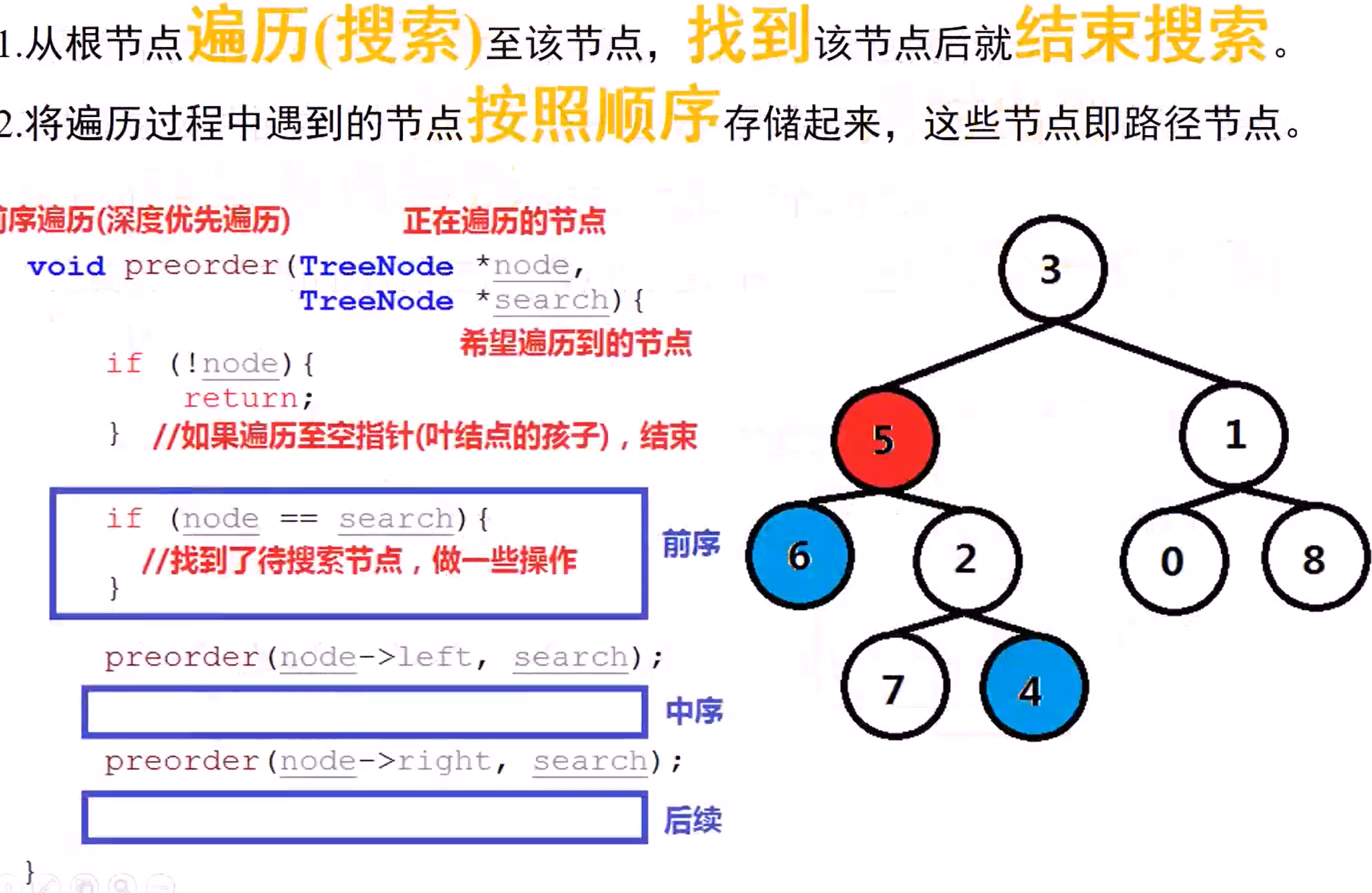
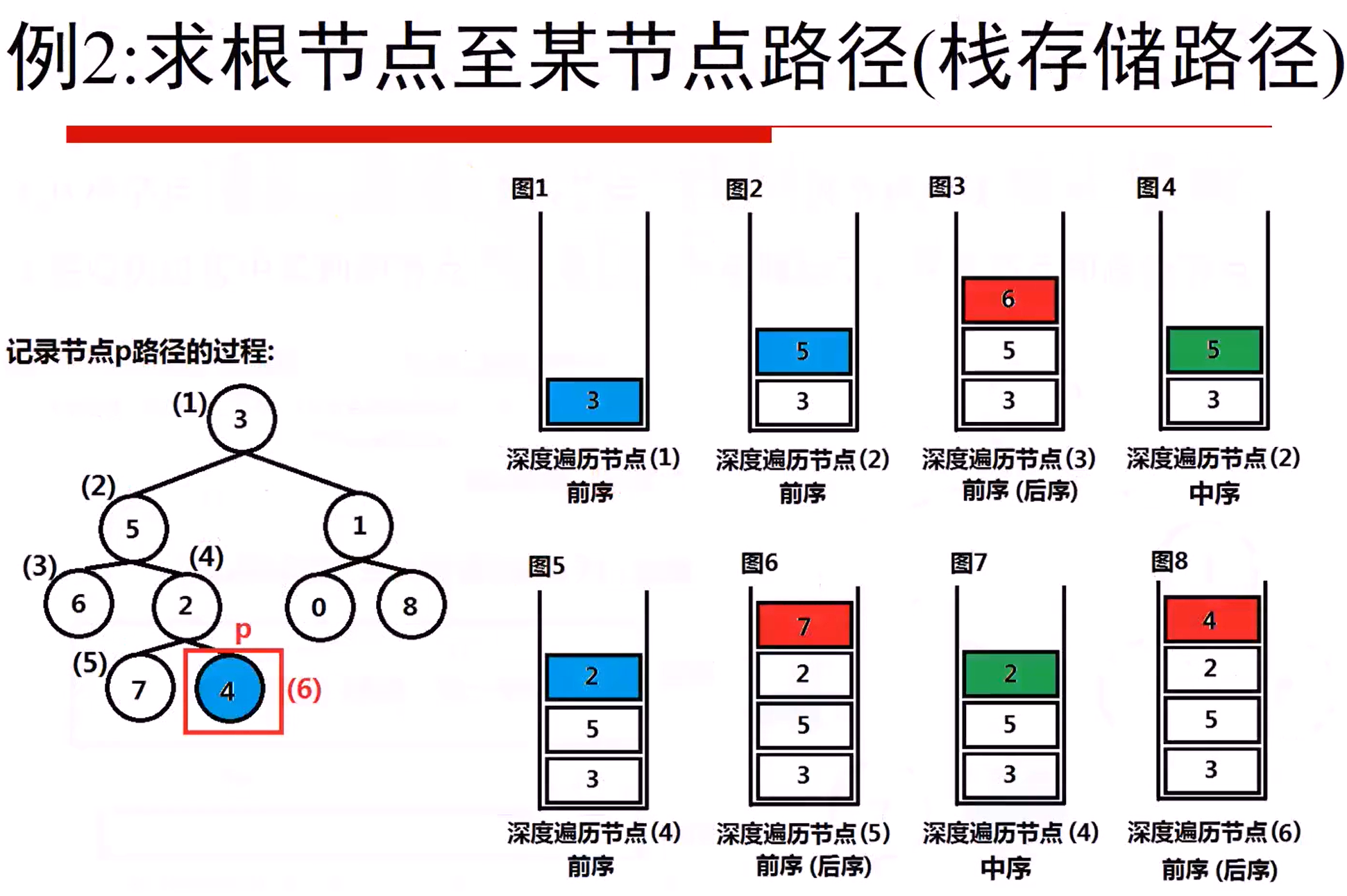
#include <iostream>
#include <vector>
#include <algorithm>
#include <stack>
#include <queue>
using namespace std;
struct TreeNode
{
int val;
TreeNode *left;
TreeNode *right;
TreeNode(int x) : val(x), left(NULL), right(NULL) {}
};
class Solution
{
private:
void preorder(TreeNode *node, //正在遍历的节点
TreeNode *search, //待搜索的节点
vector<TreeNode *> &path, //遍历时的节点路径栈
vector<TreeNode *> &result,
int &finish //记录是否找到search节点,未找到0,找到1
)
{
if (!node || finish == 1)
{
return;
}
path.push_back(node); //先序遍历时,将节点压入path栈
if (node == search)
{
finish = 1;
//2 将当前的path存储到result中
result = path;
}
preorder(node->left, search, path, result, finish);
preorder(node->right, search, path, result, finish);
//3 结束遍历node时,将node节点弹出path栈
path.pop_back();
}
public:
TreeNode *lowestCommonAncestor(TreeNode *root, TreeNode *p, TreeNode *q)
{
vector<TreeNode *> path; //声名遍历用的临时栈
vector<TreeNode *> node_p_path;
vector<TreeNode *> node_q_path;
int finish = 0;
//1
preorder(root, p, path, node_p_path, finish);
path.clear();
finish = 0; //清空path,finish,计算q节点路径
preorder(root, q, path, node_q_path, finish);
int path_len = 0; //较短路径的长度
if (/*2*/ node_p_path.size() < node_q_path.size())
{
path_len = node_p_path.size();
}
else
{
path_len = node_q_path.size();
}
TreeNode *result = 0; // 同时遍历根到pq两个节点的路径上的节点
for (int i = 0; i < path_len; i++)
{
if (/*3*/ node_p_path[i] == node_q_path[i])
{
result = node_p_path[i];
}
}
return result;
}
};
int main()
{
TreeNode a(3);
TreeNode b(5);
TreeNode c(1);
TreeNode d(6);
TreeNode e(2);
TreeNode f(0);
TreeNode x(8);
TreeNode y(7);
TreeNode z(4);
a.left = &b;
a.right = &c;
b.left = &d;
b.right = &e;
c.left = &f;
c.right = &x;
e.left = &y;
e.right = &z;
Solution solve;
TreeNode *result = solve.lowestCommonAncestor(&a, &b, &f);
printf("LCA -> %d\n", result->val);
result = solve.lowestCommonAncestor(&a, &d, &z);
printf("LCA -> %d\n", result->val);
result = solve.lowestCommonAncestor(&a, &b, &y);
printf("LCA -> %d\n", result->val);
return 0;
}
- Java
- 从根节点开始遍历树。
- 在找到 p 和 q 之前,将父指针存储在字典中。
- 一旦我们找到了 p 和 q,我们就可以使用父亲字典获得 p 的所有祖先,并添加到一个称为祖先的集合中。
- 同样,我们遍历节点 q 的祖先。如果祖先存在于为 p 设置的祖先中,这意味着这是 p 和 q 之间的第一个共同祖先(同时向上遍历),因此这是 LCA 节点。
class Solution {
public TreeNode lowestCommonAncestor(TreeNode root, TreeNode p, TreeNode q) {
// Stack for tree traversal
Deque<TreeNode> stack = new ArrayDeque<>();
// HashMap for parent pointers
Map<TreeNode, TreeNode> parent = new HashMap<>();
parent.put(root, null);
stack.push(root);
// Iterate until we find both the nodes p and q
while (!parent.containsKey(p) || !parent.containsKey(q)) {
TreeNode node = stack.pop();
// While traversing the tree, keep saving the parent pointers.
if (node.left != null) {
parent.put(node.left, node);
stack.push(node.left);
}
if (node.right != null) {
parent.put(node.right, node);
stack.push(node.right);
}
}
// Ancestors set() for node p.
Set<TreeNode> ancestors = new HashSet<>();
// Process all ancestors for node p using parent pointers.
while (p != null) {
ancestors.add(p);
p = parent.get(p);
}
// The first ancestor of q which appears in
// p's ancestor set() is their lowest common ancestor.
while (!ancestors.contains(q))
q = parent.get(q);
return q;
}
}
114 Flatten Binary Tree to Linked List(Medium)
Given a binary tree, flatten it to a linked list in-place
给定一个二叉树,原地将它展开为链表
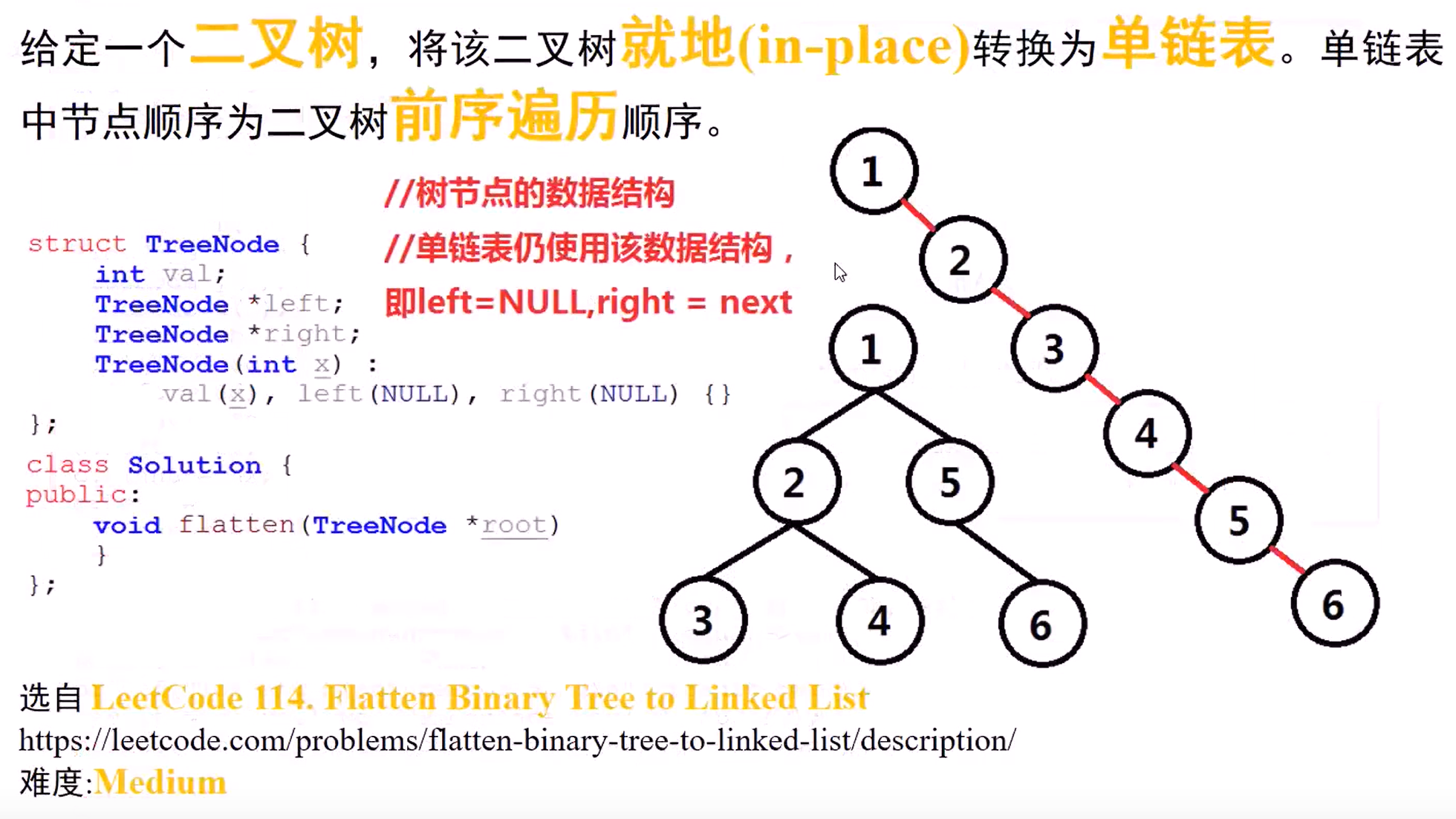
78分钟